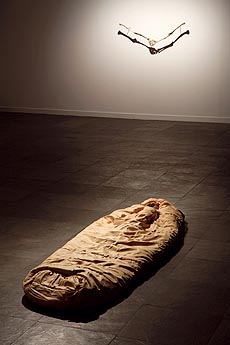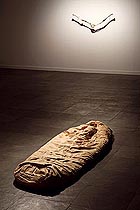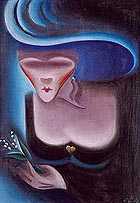
translated and summarized by: Liz Wollner-Grandville,
November 26 - December 3
Schirn Kunsthalle Frankfurt: Art Machine - Machine art
In the machine-world of art
Arrays of machines, which all seem to be operated by an invisible hand in the brightly lit Frankfurt Schirn, manufacture artwork after artwork. The exhibition rooms of the Kunsthalle have been transformed into factory premises. One apparatus is continuously drawing lines on a wall creating a huge poster in which gradually all lines come together like a grid pattern.
At the far end of the exhibit room, thick polyethylene strands created by Roxy Paine`s computer-controlled automat fall onto a conveyer belt in slow motion. The synthetic mass instantly turns into a seemingly organic object and is stacked to be marvelled at.
The contrast to the work of the three abstract art pioneers shown one floor lower - Turner, Hugo and Moreau - could not be sharper. On the one hand you have personal gestures and artistic signature and on the other an engineered arm, taking on a life of its own. Aesthetic revolutions are the main topic of this exhibit, which focuses on Jean Tinguely`s avant-garde initiation of art machines and then takes a quick turn towards contemporary art. The cooperation between the Shirn Kunsthalle Frankfurt and the Museum Tanguely in Basel form the main pillar of the exhibit.
Tinguely delegated the creative work to an apparatus with the goal of taking the innermost expression of an artist - the perception of abstraction - ad absurdum. His "Méta-Matics" are small motor-powered machines, which enable even the audience to create abstract art.
And this is where the exhibition opens a kind of dialectic debate. Now and then artists delegate their creativity and sometimes even leave it completely to someone else: what effect does this have on the definition of "artwork". The main question should therefore be, how artists continue their specific "language" with respect to a machine. After all, every apparatus carries the aesthetic and personal signature of its creator and only the output varies, depending on the origin of its context. The shiny strands produced by Roxy Paine`s machine for example seem clinically sterile in comparison to the machines designed by Jean Tinguely, who emanate a kind of art-historical poetry.
It is therefore not comprehensible why the Schirn Kunsthalle uses the same irritating bright light throughout the exhibit with obvious disregard to the diverse fascination radiated by each apparatus. Using the possibilities of contrast and distance, of mystic light, and the versatility of the venue itself was unfortunately neglected.
The exhibit does, however, convey how many noteworthy artists of the 20th century have devoted their time to this topic. Among them Damien Hirst, Rebecca Horn, Tim Lewis, Tue Greenfort and Antoine Zgraggen - just to name a few.
(60311 Frankfurt am Main, Römerberg, until 27. January 2008)
www.schirn-kunsthalle.de
Kunsthalle Wien project space: Ricky Swallow - Younger than Yesterday
Wooden Songs
On a sunny afternoon the last sunrays will throw their light onto the sparsely draped sculptures displayed in the glass exhibition hall of Vienna`s Kunsthalle project space. The Australian artist Ricky Swallow explicitly plays with these lighting conditions, as well as the low ceilinged rooms, the wide glass walls and the brawly street - all of which make his objects seem to be in a sacral ambience. Swallow utilizes the Kunsthalle exhibition space as a huge glass cabinet or glass coffin.
The artist was the Australian representative at the 2005 Venice Biennale and presented "Killing Time" a carved life size table laden with fish and crustaceans, its style being somewhat reminiscent of 17th century Dutch still life tradition. Swallow`s exhibit in Vienna shows perfectly handcrafted sculptures similar to baroque sculptures or German lime-woodcarvings made during the Renaissance, however, all of them with a touch of contemporary irritation. Buds growing out of a painstakingly carved skull, and "History of Holding": a hand emerging out of a beech wood log holding on to a peeled lemon. At first glance the sleeping bag disturbingly placed in the middle of the showroom, seems to have a shimmering micro fibre surface and only at a second glance will you discover that it is a carefully crafted piece of wood. Swallow considers the entire process of peeling a shape out of matter and forming an object of art from beginning to end as his responsibility. An attitude one does not come by often these days. But surprisingly, despite his way of working, the memento mori, and the vanitas motif, Swallow`s work never strikes the viewer as antiquated or outdated. The correlation between form and content as well as the narrative quality of his work is convincing. The sculptures develop their own iconography shaped out of the mutual cultural knowledge as well as the personal experience of the artist. The carefully worded titles of his works are targeted at enhancing the viewer`s horizon. Swallow`s work withstands contemporary trends and is worth being discovered more closely in Europe.
(1040 Wien, Karlsplatz/Treitlstrasse 1-3, until 9. December)
www.kunsthallewien.at
Leopold Museum: Grund, Mucha, Capek - Czech paintings from the Kooperativa Collection
Bohemian seascapes
The selection of Czech art from the "Kooperativa" collection, which is currently displayed at the Leopold Museum, gives the impression that abstract and non-figurative art never existed. Emphasis is mainly laid on 19th and 20th century landscape paintings, while the entire sector of Czech photography is ignored. This is mainly due to the fact that Rudolf Leopold and the CEO of the Insurance Company Mraz were responsible for selecting the displayed works,
The Slovakian portraitist Jan Kupecky, whose brilliant portrait of a sitting man strongly reminds of Fragonard, and Norbert Grund`s (a type of Czech Watteau or Guardi) park scenes and seascapes, strongly coveted by Bohemians, are among the earliest paintings shown. Alois Kirnig, Julius E. Marák and Karel Langer represent the 19th century painters. While,in comparison, Otto Gutfreund, Josef Václav Myslbek, Frantisek Bílek and Jan Stursa are somewhat weak, but well represented, works by the most prominent Czech sculptor Zdenek Pesánek, is unfortunately missing.
Only one of Frantisek Kupka`s early art-nouveau pieces as well as only one rather set back late work by Josef Capek are shown at the Leopold Museum. Main genres of Czech modern art such as Cubism and Surrealism are practically not represented at all, except for Toyen`s work, who also happens to be the only female artist exhibited.
The oeuvres displayed, which have been created after the Second World War, are mainly a continuation of ex- and impressionistic tendencies. Kinetic, conceptual and concrete art are completely ignored. It would have been more consequent to limit the exhibit to classic modern art works - all of which are of high quality.
(1070 Wien, Museumsquartier, until 4. February 2008)
www.leopoldmuseum.org
GfzK - Galerie für zeitgenössische Kunst: Ohio - Joachim Brohm with an insert by Peter Piller
Documentation and construction
The photo of the burning metallic-blue car is not unspectacular; even if the limousine has been carefully positioned into a parking space. This poster can be seen through the glass façade of the new GfzK and catches the viewer`s attention for Joachim Brohm`s solo exhibit curated by Barbara Steiner.
Joachim Brohm (born 1955), Professor of Photography and Head of the Graphics and Book Art Academy in Leipzig, is known for his unspectacular and documentary photos of urban and social transformations. While Brohm mainly concentrates on capturing situations of change, his photographic style, which is characterized by a balanced composition and restrained colours, reflects the methods and self-conception of documentary photography.
Brohm`s Series "Ruhr" (1979 - 1983), "Areal" (1992 - 2002), "Fahren" (2004 - 2005), the Dutch SKOR-Project (2003) and the Series "Ohio", which is also the title of the exhibit, are all displayed at the GfzK. Ohio was created during a study visit to the USA in 1983 - 1984 and is the starting point of the exhibition, which offers a broad overview of Brohm`s work and his development.
"Areal" is an artistic highlight in which Brohm, over a time span of 10 years, documents the transformation of an abandoned industrial site near Munich into a post-industrial residential area. The rusty metal of a minibus turns into a sand picture, the tiled house façade into patchwork, and the water hydrant into a cactus.
The presentation of this series in combination with numerous smaller photos, covering the entire wall, is exceptionally good.
The arrangement resembles an archive and points to an "All-over" style, anchored in non-accentuated colours and compositions. This allows the onlooker to broaden his view towards Brohm`s work and the numerous possibilities offered by documentary work.
(04107 Leipzig, Karl-Tauchnitz-Strasse 11, until 13 January,2008)
www.gfzk.de
Mehr Texte von translated and summarized by: Liz Wollner-Grandville


 Teilen
Teilen




